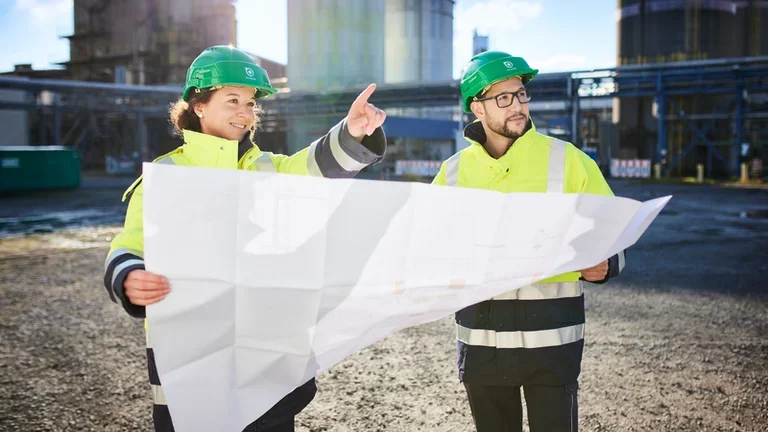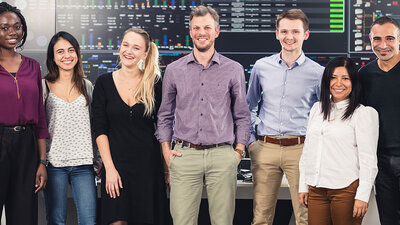In a rapidly changing world, Air Liquide’s business model is demonstrating its strength and resilience in response to the challenges of multiple transitions. At the cutting edge of technological innovation notably in the fields of energy transition and electronics, the Group stands out with its ability to collaborate with strategic partners. Benoît Potier, Chairman of the Board of Directors, and François Jackow, Chief Executive Officer of Air Liquide, share their perspectives.
How does the changing global environment influence Air Liquide’s strategic vision?
Benoît Potier: Geopolitical and economic fragmentation is redefining the global balance of power. We are witnessing a global clusterization, with the world operating increasingly through communities of interest and alliances. At the same time, major transformations (demographic, climate, digital and societal) are also having an effect. In response to these challenges, Air Liquide is strategically positioned to provide relevant solutions and support its customers in these major transitions. Our global presence and our long-standing ties with key industrial basins are part of our structural advantages that enable us to serve a wide range of sectors. Drawing on our mastery of essential molecules and our ability to innovate, we continuously develop new solutions to meet emerging needs. We integrate the very best technologies into our products to benefit our customers and patients. We have always aimed to play a pioneering role by embracing emerging trends in response to global transformations, all with a market-driven approach. This is still the case, now more than ever! We are visionaries, taking immediate and tangible action to contribute to the world’s transformations.

“The transition to a carbon-neutral economy by 2050 starts now.
”
Benoît Potier
Chairman of the Board of Directors
In this context, how would you assess the Group’s performance in 2024?
François Jackow: I am extremely proud of the Group’s very solid financial performance. It is all the more remarkable in a year marked by macroeconomic tensions and the Group’s structural transformation. This performance has led to improved results in several areas. We achieved a record improvement in our operating margin of more than 110 basis points(1). Encouraged by this result, which was made possible by record efficiencies of nearly 500 million euros, we have decided to raise and extend our margin ambition, now targeting an increase of +200 basis points for the period 2025-2026, representing an unprecedented total increase of +460 basis points(1) over five years (2022-2026). There has also been growth in sales, which now amount to more than 27 billion euros, up +2.6%(2), in sluggish market conditions. These sales figures are further proof of Air Liquide’s significant resilience, driven particularly by Industrial Merchant in North America, Electronics in Asia and Healthcare. The Group’s recurring net profit(3) increased by +11.5% and recurring ROCE is at +10.7%, even though our investments are increasing. Now more than ever, we are continuing to prepare the future, with sources of growth fueled by our record investment decisions in 2024, reaching 4.4 billion euros.
Our ability to provide our customers with innovative products and services with a technological focus is reflected in major commercial successes in both traditional sectors and the transformation-driven fields of the energy transition and semiconductors. For example, the contracts signed with LG Chem and GlobalFoundries in the United States, Wanhua in China and Aurubis in Europe are proof of the relevance of our offerings. These successes come alongside a growing number of large-scale projects, such as the continued development of our low-carbon hydrogen ecosystem in the Normandy industrial basin, the project of a low-carbon oxygen platform for ExxonMobil in the United States (which would be the Group’s largest investment in its history!) and major investment projects, working with TotalEnergies, for the construction of two very large-capacity electrolyzers to accelerate decarbonization in Europe.
Moreover, several of our projects have received support from the European Union, including the D’Artagnan CO2 infrastructure project, managed with Dunkerque LNG, to decarbonize the Dunkirk basin, the carbon capture and storage project in Denmark with Cementir and the large-scale project for the production, liquefaction and distribution of low-carbon and renewable hydrogen from ammonia in the port of Antwerp-Bruges in Belgium. This support is an acknowledgment of the relevance of our technological solutions in response to the challenges of the energy transition and their key role in tomorrow’s industry.
We owe these major advances to the remarkable dedication of our teams around the world. Every year, they push boundaries, innovate and rise to new challenges, contributing to the Group’s growth and transformation.
What can you tell us about your extrafinancial performance?
F.J.: Our extra-financial results are solid on all indicators of our ADVANCE plan. On safety, which is of paramount importance, I would like to thank all of our teams for their remarkable mobilization, which allowed us to make progress in 2024. On the environmental front, we have reduced our CO2 emissions by 11%(4) compared with 2020, confirming that we are ahead of schedule in achieving our inflection target by 2025. Our carbon intensity has decreased by 41%(5) compared to 2015, already surpassing our reduction target of 30% set for 2025. In terms of diversity, women currently represent 33% of the Group’s Managers and Professionals, while all Air Liquide employees now benefit from a common basis of care coverage, one year ahead of our target.
Once again, this progress is the result of the tireless work of the teams and their unwavering commitment to the environment, safety and inclusion. At a time when a decline is being seen in some of these areas, these results are all the more remarkable and meaningful, demonstrating our determination to go even further. I would particularly like to thank our staff for their vital contribution. I have every confidence in them and in our collective ability to drive our performance again in 2025.
What are the strengths of Air Liquide’s model when it comes to responding to the challenges of a changing world?
B.P.: Our model is unique. It is built on a broad range of markets, applications and geographies and makes our Group particularly resilient. We are strategically located on five continents, yet we also have in-depth knowledge of local industrial networks. This solid foundation enables us to offer useful and customized solutions, drawing on best practices on a global scale, while developing strong relationships with our customers, underpinned by long-term contracts and strategic partnerships. Increasingly, we are joining coalitions and playing the role of facilitator within multi-stakeholder ecosystems. This role highlights our expertise and our abilities to innovate and develop trusted relationships as we work closely with our teams, customers, partners and shareholders. This trust is built on quality dialog. This unique and proven model has successfully navigated crises while creating value.
F.J.: To continue the progress made so far, maintain our agility and enhance our performance, we have launched an ambitious internal transformation program. Our fundamentals, namely safety, customer satisfaction and employee engagement, are deeply rooted in the Group’s culture. To sustain this corporate culture, we recognize the need to simplify our organization to become even more proactive, competitive and attractive, ensuring that we are better prepared for the challenges of tomorrow. This simplified structure will facilitate quicker decision-making and increased efficiency, while the creation of a new single Group Industrial Direction will develop operational synergies. This transformation plan will give us the means to continue to seize market opportunities created by the challenges of the world’s ecological, economic and societal transitions. There have never been so many and such large-scale opportunities. We must make the most of them!

“Continuing to develop solutions that address the world’s challenges and create value is the strength and the hallmark of our business model.
”
François Jackow
Chief Executive Officer
To what extent do the Group’s activities, products and technological solutions contribute to creating a positive impact?
F.J.: Our innovation is strongly focused on technologies with a positive impact. More than 3,000 employees are dedicated to innovation, working tirelessly with the Group’s operational teams to optimize the use of molecules and improve the efficiency of industrial processes and our healthcare solutions. They are tasked with developing effective and useful solutions for society as a whole. In terms of decarbonization, this includes the supply of low-carbon gas, oxy-combustion, capture solutions for CO2 sequestration and renewable and low-carbon hydrogen production plants. These solutions are implemented in various sectors, including those that are the hardest to abate, such as the cement industry. Our efforts also extend to the transformation of healthcare systems: we provide hospitals with low-carbon molecules and we offer solutions that combine human interaction and digital technologies to better support patients treated at home. This technological expertise is also reflected in our support for the growth of the semiconductor industry. Today, it is a vital industry for many everyday activities, including communication, transportation and even healthcare, and our gas solutions and services make a difference, both in terms of performance and carbon footprint. Lastly, we leverage our long-standing expertise in industrial processes by providing increasingly advanced and innovative solutions to support our customers every day as they work to continuously improve their products.
B.P.: Our impact is at the heart of our deliberations and decision-making processes at all levels of the company. Sustainable development is one of the key priorities of our ADVANCE plan and the work of our Board of Directors, which is knowledgeable about this topic and includes an Environment and Society Committee which closely monitors our objectives and our undertakings. Our commitment to sustainability reflects our desire to create a positive impact. We have committed to a 33% reduction in our CO2 emissions(6) by 2035 through low-carbon hydrogen, CO2 capture and the electrification of industrial processes. This trajectory is integrated into our investment decisions and the environmental impact of our projects is given careful and exacting consideration. The social aspects (safety, social coverage, diversity) on which we have made progress are also monitored by the Board. We are mindful that our impact also relates to our governance. Our governance must be exemplary and I want to commend the efforts and commitment of our Directors in this regard.
What are the main challenges in the short term?
B.P.: We must adapt to numerous changes, geopolitical tensions, the rise of artificial intelligence and the acceleration of economic cycles. We must become more agile while remaining attentive to emerging trends and weak signals from our various markets to ensure that we can anticipate these transformations. I have the utmost confidence in our values, which serve both as the cornerstones of our business model and as a frame of reference; they must help us move forward and consolidate our position. This is particularly important, given the increasingly urgent need for companies to transform: the transition to a carbon-neutral economy by 2050 starts now. This will involve accelerating our partnerships and the joint development of solutions with industrial and institutional partners, because these challenges are complex and go far beyond the scope of individual companies and countries. Major challenges such as the transport and storage of CO2, access to renewable energy and the development of low-carbon hydrogen infrastructure require a collective and coordinated approach. To achieve this, there will need to be a simplified regulatory framework that is tailored to the competitive environment of the future. A pragmatic and flexible approach will facilitate the rapid and efficient development of these new ecosystems: this will be one of the challenges facing our industries, particularly in Europe.
What are the priorities in response to these challenges?
F.J.: Firstly, we must continue to develop solutions that address the world’s challenges and create value – that’s the strength and the hallmark of our business model, which has proven itself time and time again. We are also going to enhance our competitiveness by continuing the Group’s transformation to achieve improved performance that benefits our customers and patients. We remain firmly committed to the energy transition, despite the changing views of some political and economic stakeholders. This commitment is reflected in our continued efforts to reduce our carbon emissions and support our customers as they work towards decarbonization. Similarly, we continue to focus on healthcare and semiconductors, two strategic sectors with real promise as we prepare for the future. To put it another way, our priority is to show that, day after day, we are a productive and useful company that is worthy of the trust put in us by all our stakeholders. We will do this by creating value for our employees, customers, patients and shareholders, while striving to make a useful contribution to our world.
(2) On a like-for-like basis
(3) Excluding currency impact and exceptional and significant operations that do not impact operating profit
(4) Emissions are reported by the Group in scopes 1 and 2, using a “market-based” methodology, and are restated, from 2020 and each subsequent year, to take into account changes in scope having a significant impact (upwards and downwards) on CO2 emissions
(5) In kg CO2 equivalent/euro of operating profit before depreciation and excluding IFRS 16 at the 2015 exchange rate on scopes 1 and 2 “market-based” greenhouse gas emissions
(6) Scopes 1 and 2 absolute emissions



